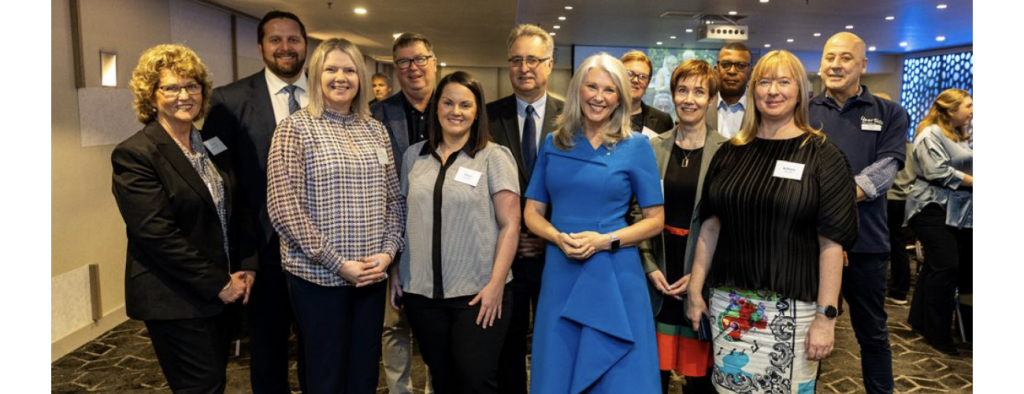
Care Finder Launch event attendees from Western Sydney Primary Health Network, Aspire4Life, Your Side and Parliament (from left to right):
Michelle Marchant, Michael Scurrah, Kristy Butler, Peter Smales, Allison Carter, Hon. Mark Hodges, Tracey Spicer, Elizabeth Foxhall, Michelle Quinn, Jelly Magirazi, Brittany Jack and Paul Tratt.
The aged care system is complex, and some people find it more difficult than others to navigate and access the services they need. While My Aged Care is the single-entry point for people to learn about and access aged care services, there have been long-standing calls for more localised and face-to-face support to help people navigate and access aged care.
At the end of 2022, we invited organisations to be part of a rigorous procurement process which led to the selection of two new Care Finder providers, Aspire4Life and Your Side Australia, and two transitioning providers from the Assistance with Care and Housing services, Wesley Mission and HammondCare.
On Tuesday 15 August, we celebrated the official launch of the Care Finder program in Western Sydney. Our Senior Director of Strategic Commissioning, Michelle Quinn, shared, “So far, we are seeing great results. In under six months, our four Care Finder organisations have seen over 150 clients, 100% of whom reported that the program was appropriate for their needs, the provider was trustworthy, and they were satisfied with the outcome of their engagement. This kind of feedback is incredibly heartening, particularly this early on… Already, we are gaining feedback from local health professionals on the need for this service, with 30% of referrals coming through from GPs or health professionals.”
The Care Finder program is for people who are eligible for aged care services and do not have a support person who they are comfortable acting on their behalf or who is willing and able to support them to access aged care services via My Aged Care.
Care Finder organisations connect their clients with a care finder who will meet them, usually in person, at their home or another place they choose. The care finder will ask questions to understand the client’s situation and support them in working through the steps to address their needs. This includes helping the client access services for the first time and changing or finding new services and supports, filling out forms and ensuring the client is engaging in a service.
Eligible clients must also have one or more of the following reasons for requiring intensive support:
- Communication barriers, including limited literacy skills and difficulty processing information to make decisions
- Resistance to engage with aged care for any reason and their safety is at immediate risk
- They may end up in a crisis situation, approximately within the next year
- Past experiences have made them hesitant to engage with aged care, institutions or government
The Care Finder Process from the Client’s Perspective
The following stories illustrate examples of clients who would benefit from the Care Finder program.
Mary's story
Mary* is 82 years old. Her husband passed away five years ago, and her three children have moved away. Her hearing ability has been deteriorating and her GP recently diagnosed her with early stages of dementia. Her GP suggested seeking help through My Aged Care, but Mary thinks this means she would have to move into an aged care facility, so did not access My Aged Care services.
Mary speaks to her children regularly but is not willing to admit she is having trouble keeping the house clean and has not told them about her dementia diagnosis. She is less connected with her community than she used to be and is no longer confident to drive. She also does not know how to use a computer or have access to the Internet.
John's story
John* is 66 years old and has experienced long-term mental health challenges. He has been unable to work for many years and has lived with his sister for most of his adult life. His sister is in her seventies and has recently moved into residential aged care and given up her rented flat.
John no longer receives support from his sister and does not have financial support from the government as he is afraid of sharing his personal situation. He has moved in with an old friend as a short-term solution, but there isn’t much space for him. John now feels vulnerable as he is at risk of homelessness.
Find out how a care finder can get involved in Mary and John’s journeys.
*The clients mentioned in these stories are fictional.
How Do I Connect Someone with a Care Finder?
As a health professional, you can call one of the Care Finder organisations to help connect your patient with this service:
- Aspire4Life – 1300 012 056
- Your Side Australia – (02) 8405 4484
- HammondCare – 1800 776 112
- Wesley Mission – (02) 9263 5177
When you call, you will need to answer some questions about why the person needs help from a care finder. The person must give consent for you to provide this information, so it is best if they are with you when you call.
Alternatively, please complete the Your Side Australia referral form or the Aspire4Life referral form.
For more information, please visit our Care Finder webpage.
Translated Resources for Patients
Your Side Australia has developed translated Care Finder information health professionals can print or share with their patients in the following languages:
The English version is also available.
17 August 2023.